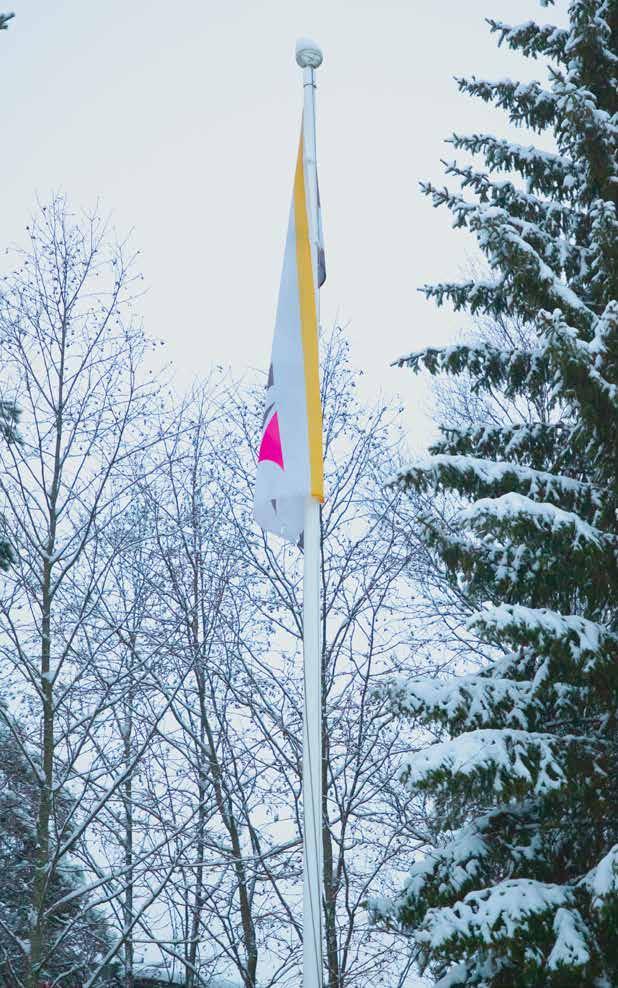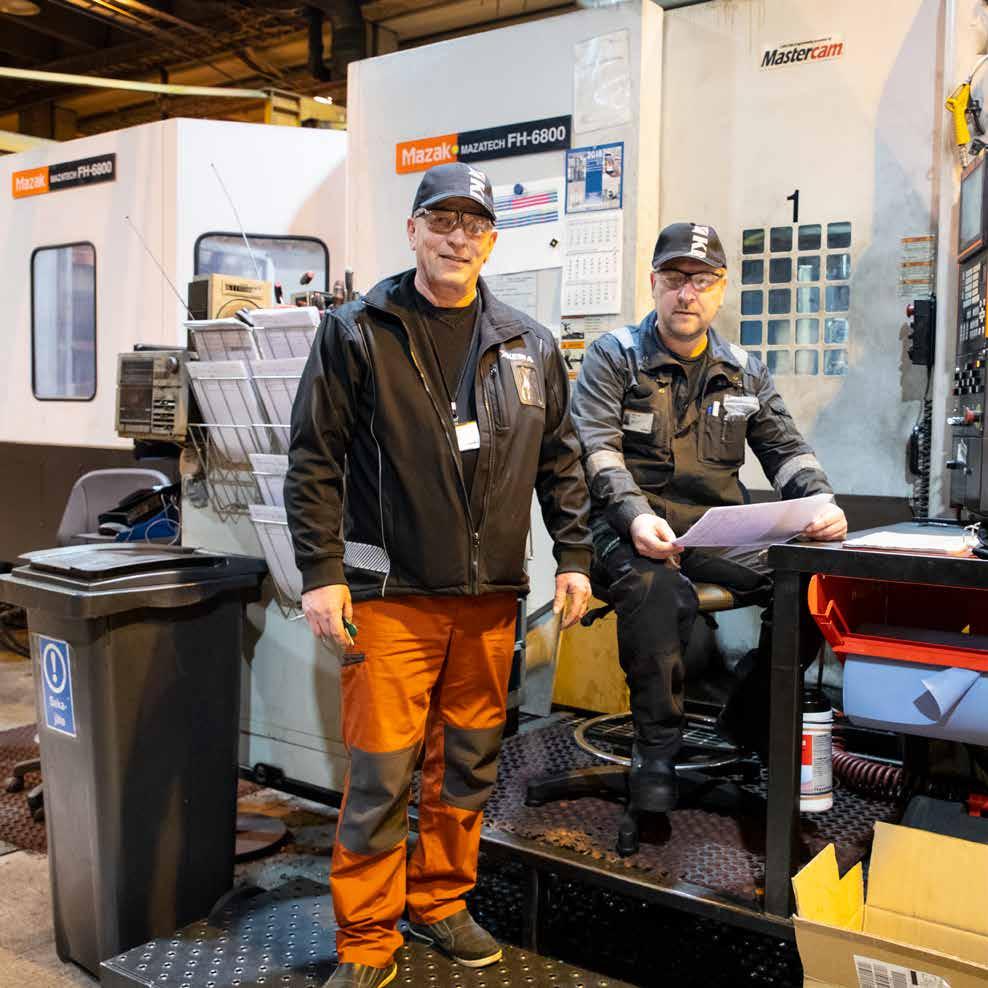
7 minute read
Ilomantsi’s via dolorosa ends with flag raising
In April 2016, Kesla’s subsidiary MFG Components announced that it was negotiating the closure of its Ilomantsi machine engineering workshop. According to the stock exchange release, the closure was planned for the end of the same year, due to “the prolonged weak financial situation of the Ilomantsi machine engineering workshop”. The employees of the Ilomantsi unit responded to the news with a walkout. The escalation of the wretched situation began many years earlier.
Ilomantsi had manufactured hydraulic cylinders and machining parts for Kesla’s products. In 2005, the machine engineering workshop was incorporated into Kesla Components Oy, a wholly-owned subsidiary of Kesla. Jari Nevalainen, then CEO of Kesla, described the in-corporation in an interview on 27 October 2009: “Until the incorporation, the Ilomantsi factory had been carried by its parent company without any real market pressure. Operations were too passive – they just delivered what Kesla ordered. The incorporation seeks to change the situation and activate sales.” Founded by the late Pekka Shemeikka, MFG had produced a decent result. The purchase price of the company has even been described as cheap. Even so cheap that 12 years after the transaction Veli-Matti Kärkkäinen, Chairman of Kesla’s Board of Directors, described the transaction as follows: “Just like Sulo Vilén – we bought it because it was cheap.” Sulo Vilén was a Finnish comedy character in the late 1970s. In the TV series, Vilén was an unlucky service station entrepreneur whose business was not going well at all, but who kept buying all kinds of things – because they were cheap.
“Just like Sulo Vilén”
In 2007 Kesla had purchased MFG Components, a company based in Tohmajärvi, which was supposed to bring with it the sales know-how of machine engineering systems and also external customers. The idea was to give the company more supports in order to make it less dependent on the cycles of the forest industry.
Motivation put to test
When Kesla purchased MFG Components in 2007, the product range of the Ilomantsi machine engineering workshop changed. The atmosphere was described by Harri Mustonen, who joined the company in 1997. He observed the goings-on in Ilomantsi as a production worker and team leader: “The Ilomantsi machine engineering workshop made parts for Kesla and also for external customers. They were often individual pieces, which took a lot of time and labour. There were all kinds of disturbances and delays – many products were not at all suitable for our production and the operations were not profitable.” When production stalled, Kesla had to buy the products it needed from abroad. Everyone in Ilomantsi knew the reasons for the losses. The situation took its toll on the team’s motivation.
Bad personal chemistry
Juha Tahvanainen, who worked as a mechanic in Ilomantsi for 25 years, explains that he understands Kesla’s management’s motives regarding MFG, but in his opinion the implementation started off on the wrong track right from the start. A manager was elected from in-house to run the company. There was bad personal chemistry, and the workers in Ilomantsi felt that they were being treated condescendingly.
Time of crisis
Kesla’s turnover had dived in 2015, due, for example, to the crisis in Crimea. At the same time, Kesla was in the middle of a cash crisis. On 27 May 2015, the company announced that it had appointed a new CEO. Saastamoinen had already jumped to the position of interim CEO in spring 2015, when Jari Nevalainen’s service as CEO of Kesla ended.
Opportunity to sell
Manufacturing engineer Simo Saastamoinen was now the number one man in a listed company which, in his own words, started to push forward with a “horrible handicap”. While the closure of the Ilomantsi machine engineering workshop was discussed in April 2016, in May of the same year Kesla announced that it was negotiating the sale of the Ilomantsi machine engineering workshop. Kesla CEO Simo Saastamoinen confirmed that serious discussions on the sale took place with two domestic metal companies. Saastamoinen commented on sales intentions in an Yle news story on 11 May 2016: “There is no certainty yet. And MFG hasn’t even decided to close the Ilomantsi machine engineering workshop yet. In any case, we want to do everything in our power to keep the operations there going.” In the same Yle news story, it was stated that “While Kesla is in charge, operations in Ilomantsi do not seem likely. The subsidiary MFG Components’ second branch in Tohmajärvi is not covered by the co-determination negotiations.”

Harri Mustonen (left) and Juha Tahvanainen – proud members of the Kesla squad.
At the time, 46 people worked at the Ilomantsi unit. The atmosphere was bleak, and some of the employees left on their own initiative. A machine tool and two robot cells were moved from the machine engineering workshop to Tohmajärvi. The outlook was that in a few weeks or months, Ilomantsi’s production bay of slightly less than 400 square metres would lie empty.
An Italian strike
When the end was in sight, the workers in Ilomantsi responded with a so-called Italian strike. The goal was to wake up Kesla’s leadership. The people were at work and the machines were running, but no completed products left the building. After the Italian strike had lasted for a couple of weeks, Timo Ala-Jääski went to give them a loud talking-to. The employees did not bat an eyelid, as they had already been handed their notice.
Change of plan
During 2016, Kesla was able to make profit again. The big news was that instead of getting rid of the Ilomantsi machine engineering workshop, Kesla wanted to get rid of MFG Components. MFG Components employed some forty people in Tohmajärvi. According to Kesla, the conditions for the sale of MFG were good since, for example, the maritime industry seemed to have recovered.
Kesla Group focused again on forest machines. The operating loss of €1.5 million in 2015 was turned into a profit of just under €1 million in 2016. In Ilomantsi, the complete reversal of the closure plans was seen to be mainly due to the rise in the economic cycle in the forest industry. As the market strengthened, Kesla had better secure the availability of hydraulic cylinders and machining in its own camp. The purpose of the Ilomantsi unit is not to minimise unit costs, but to keep Kesla’s wheels spinning. Delivery time and security of supply are key.
Raising the Kesla flag
Machinist Juha Tahvanainen was interviewed for the Kesla personnel’s internal information channel in the autumn of 2018. Tahvanainen says that Kesla’s collective spirit is now top notch. The Machinist feels literally like a “Proud member of the Kesla squad”. When asked about memorable events over the years, Tahvanainen did not hesitate for a moment to answer: “When the co-determination negotiations to close the Ilomantsi station were in the final stretch, CEO Simo Saastamoinen came to Ilomantsi, asked us to raise the Kesla flag back on the flagpole and said that no one would be fired.”
Harri Mustonen, who was appointed Production Manager of the Ilomantsi machine engineering workshop in 2018, said:
“The result left a good feeling”
Markku Lappalainen served as Mayor of Ilomantsi in 2007–2017. Lappalainen recalls the critical stages of Kesla’s Ilomantsi factory at a time when other bad news were also heard in Ilomantsi. The University of Eastern Finland was closing down the Mekrijärvi research station, and Vapo had announced the closure of its pellet factory.
“Kesla’s CEO Simo Saastamoinen contacted us with the aim of opening a discussion on whatoptions would be available in the difficult situation. Kesla was an important company for Ilomantsi,a significant industrial employer,” says Lappalainen.
One of the options discussed was that the municipality of Ilomantsi could buy Kesla’s production bay. This would have eased Kesla’s cash situation and the company would have continued to operate as a tenant in the building. The municipality began to consider the establishment of a business real estate company even before the new municipal law required it. Another alternative was that another company would have joined Kesla in the industrial hall. Discussions were also held with investors.
The municipality did not rest on its laurels, and there was good communication with Kesla. According to Lappalainen, the issues were weighed thoroughly and in good cooperation. In terms of information, the municipality of Ilomantsi had a strict policy; Kesla had full responsibility for distribution of information. The knot finally started to unravel for the best from Ilomantsi’s perspective. Lappalainen estimates that the motivation and determination of the personnel of Kesla’s Ilomantsi factory played a big role in the solution, in addition to the increased demand in the forest machine market.
“CEO Saastamoinen called and asked for a meeting. If I remember correctly, it was a warmsummer Friday when Simo rode his motorcycle to Ilomantsi. He explained the solution tothe situation and thanked the municipality for exploring alternatives during the process. Theevents and Kesla’s way of working left a very good feeling. The result was good for Ilomantsi,and I could leave the meeting for the weekend with a light heart.”

Today’s Ilomantsi team does not lack motivation.










